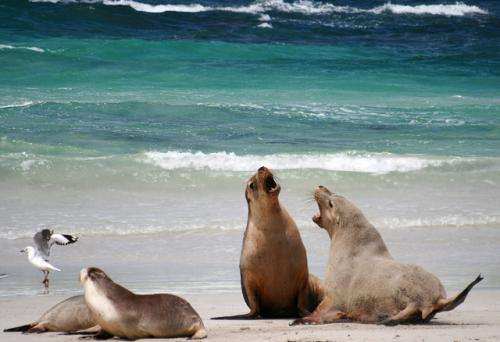Little is known of the effect of Giardia infection on Australian sea lions. Credit: Nicolò Bonazzi
A startling proportion of West Australia's sea lion population is infected with the parasite Giardia duodenalis, research has found.
Macquarie University's Tiffany Delport used genomic sequencing to test the faecal samples of wild and captive Australian sea lions (Neophoca cinerea), searching for the tell-tale DNA of parasites Giardia and Cryptosporidium.
Ms Delport found the rate of Giardia infection was highest in captive sea lions, closely followed by Australian sea lion colonies situated within 25km of human coastal settlements.
In WA, Beagle and North Fisherman Islands are home to two wild sea lion colonies, 17.7km and 21.6km from human settlement respectively.
Ms Delport says of the 30 faecal samples collected from these islands, 12 were positive for Giardia—an infection rate of about 40 per cent.
Parasite dispersed from human sources
Transmitted through the ingestion of contaminated food and water sources, Giardia can spread from human to mammal, and from land mammal to marine mammal, Ms Delport says.
"Taking steps to minimise environmental pollution with human and domestic animal faecal material infected with cysts may reduce the spread of Giardia to mammalian wildlife populations," she says.
"It is also important to consider that Giardia cysts are environmentally robust, capable of surviving extended periods of time outside of a host."
Ms Delport says in humans and domestic animals, Giardia can cause diarrhoea and loss of appetite.
"However, very little is known about the effects that Giardia has on many wildlife hosts, including marine mammals," she says.
"As Giardia is observed in many marine mammal species, including endangered animals such as the Australian sea lion, it is important that future investigations monitor the impact of infection on host health and identify potential pathways from humans and terrestrial animals to wildlife populations."
Ms Delport did not find evidence of Cryptosporidium cysts in wild or captive sea lion populations.
More information: Tiffany C. Delport, Amy J. Asher, Linda J. Beaumont, Koa N. Webster, Robert G. Harcourt, Michelle L. Power, "Giardia duodenalis and Cryptosporidium occurrence in Australian sea lions (Neophoca cinerea) exposed to varied levels of human interaction," International Journal for Parasitology: Parasites and Wildlife, Volume 3, Issue 3, December 2014, Pages 269-275, ISSN 2213-2244, dx.doi.org/10.1016/j.ijppaw.2014.09.001.
Provided by Science Network WA





















